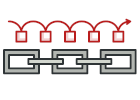
Chain of Responsibility em TypeScript
O Chain of Responsibility é um padrão de projeto comportamental que permite passar a solicitação ao longo da cadeia de handlers em potencial até que um deles lide com a solicitação.
O padrão permite que vários objetos tratem a solicitação sem acoplar a classe remetente às classes concretas dos destinatários. A cadeia pode ser composta dinamicamente em tempo de execução com qualquer handler que siga uma interface de handler padrão.
Uso do padrão em TypeScript
Complexidade:
Popularidade:
Exemplos de uso: O padrão Chain of Responsibility não é um padrão frequente em um programa TypeScript, pois é relevante apenas quando o código opera com cadeias de objetos.
Identificação: O padrão é reconhecível pelos métodos comportamentais de um grupo de objetos que indiretamente chamam os mesmos métodos em outros objetos, enquanto todos os objetos seguem a interface comum.
Exemplo conceitual
Este exemplo ilustra a estrutura do padrão de projeto Chain of Responsibility. Ele se concentra em responder a estas perguntas:
- De quais classes ele consiste?
- Quais papéis essas classes desempenham?
- De que maneira os elementos do padrão estão relacionados?
index.ts: Exemplo conceitual
/**
* The Handler interface declares a method for building the chain of handlers.
* It also declares a method for executing a request.
*/
interface Handler {
setNext(handler: Handler): Handler;
handle(request: string): string;
}
/**
* The default chaining behavior can be implemented inside a base handler class.
*/
abstract class AbstractHandler implements Handler
{
private nextHandler: Handler;
public setNext(handler: Handler): Handler {
this.nextHandler = handler;
// Returning a handler from here will let us link handlers in a
// convenient way like this:
// monkey.setNext(squirrel).setNext(dog);
return handler;
}
public handle(request: string): string {
if (this.nextHandler) {
return this.nextHandler.handle(request);
}
return null;
}
}
/**
* All Concrete Handlers either handle a request or pass it to the next handler
* in the chain.
*/
class MonkeyHandler extends AbstractHandler {
public handle(request: string): string {
if (request === 'Banana') {
return `Monkey: I'll eat the ${request}.`;
}
return super.handle(request);
}
}
class SquirrelHandler extends AbstractHandler {
public handle(request: string): string {
if (request === 'Nut') {
return `Squirrel: I'll eat the ${request}.`;
}
return super.handle(request);
}
}
class DogHandler extends AbstractHandler {
public handle(request: string): string {
if (request === 'MeatBall') {
return `Dog: I'll eat the ${request}.`;
}
return super.handle(request);
}
}
/**
* The client code is usually suited to work with a single handler. In most
* cases, it is not even aware that the handler is part of a chain.
*/
function clientCode(handler: Handler) {
const foods = ['Nut', 'Banana', 'Cup of coffee'];
for (const food of foods) {
console.log(`Client: Who wants a ${food}?`);
const result = handler.handle(food);
if (result) {
console.log(` ${result}`);
} else {
console.log(` ${food} was left untouched.`);
}
}
}
/**
* The other part of the client code constructs the actual chain.
*/
const monkey = new MonkeyHandler();
const squirrel = new SquirrelHandler();
const dog = new DogHandler();
monkey.setNext(squirrel).setNext(dog);
/**
* The client should be able to send a request to any handler, not just the
* first one in the chain.
*/
console.log('Chain: Monkey > Squirrel > Dog\n');
clientCode(monkey);
console.log('');
console.log('Subchain: Squirrel > Dog\n');
clientCode(squirrel);
Output.txt: Resultados da execução
Chain: Monkey > Squirrel > Dog
Client: Who wants a Nut?
Squirrel: I'll eat the Nut.
Client: Who wants a Banana?
Monkey: I'll eat the Banana.
Client: Who wants a Cup of coffee?
Cup of coffee was left untouched.
Subchain: Squirrel > Dog
Client: Who wants a Nut?
Squirrel: I'll eat the Nut.
Client: Who wants a Banana?
Banana was left untouched.
Client: Who wants a Cup of coffee?
Cup of coffee was left untouched.